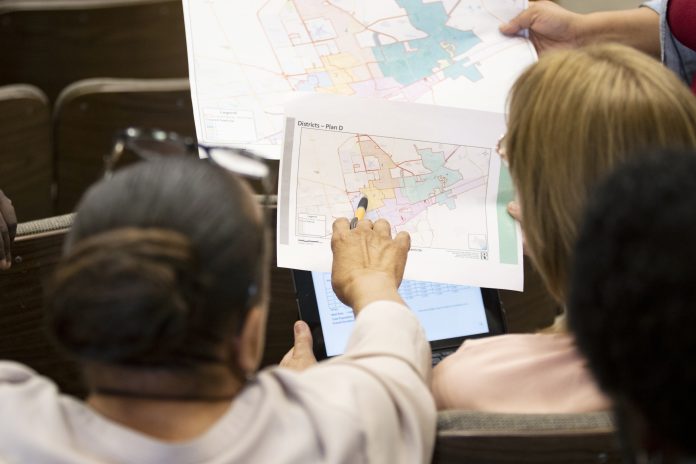The Odessa City Council unveiled two proposed redistricting plans during a specially scheduled public hearing Monday afternoon and while only three members of the public spoke up, they all expressed concerns Odessa’s minority populations weren’t included in the process.
Sydney Falk, a demographer and attorney with the Austin law firm of Bickerstaff, Heath, Delgado and Acosta, explained to the sparsely attended gallery that the law requires all city council districts to be within 10% of each other population-wise.
Using a PowerPoint presentation, Falk explained that ideally, each district should have 22,897 people in it, but the latest Census figures show Districts 2 and 4 are over-populated by 22 and 24% respectively while the other three districts are under-populated by 14-16%.
The latest Census figures show Odessa’s overall deviation from the ideal district populations is nearly 41% so the city has to re-design its districts, Falk said.
Councilwoman-at-large Denise Swanner has represented the city during the process, which began in January. City Attorney Natasha Brooks and City Manager Michael Marrero also participated in the discussions.
On Monday, Falk presented two plans the council has determined are the best to choose from, with Plan D being largely written by Swanner. Mayor Javier Joven and Councilmember Mari Willis were not present.
Under Plan A, the overall deviation number drops to 6.33% and under Plan D, that number is 6.10%, Falk said.
NAACP President Gene Collins, Black Cultural Council of Odessa President Jo Ann Davenport Littleton and resident Darlene Mays all expressed dismay they and other members of Odessa’s minority population had not been informed of the ongoing process.
In years past, Collins said he was included in the discussions particularly because of past litigation regarding single member districts.
“I’m sorry that you feel you were not represented,” Swanner said in response to Littleton’s comments.
Under Plan A, District 1’s Hispanic population will fall from 66% to just under 61% and the Black population will fall from 11% to 9.34%. District 5’s Hispanic population will drop from roughly 77% to just over 75% and the Black population will rise from just under 4% to 4.7%.
Under Plan D, District 1’s Hispanic population will drop from 66% to just under 55% and the Black population will change from 11% to 9.54%. In District 5, the Hispanic population will increase to nearly 78% from roughly 77% and the Black population will rise to 4.45% from just under 4%.
Collins told the council he was surprised about the lack of communication.
“As all of you know, under the Voting Rights Act, our organizations can file an enforcement action at any time. If you move a voting box we can solve and get that move back if it was done with the intent of skewing an election, so it would seem natural that those groups that represent minority organizations would be contacted early in the process to make sure there were no complaints and that they felt that you were doing things that were equal and fair to their constituents,” Collins said.
Having been involved in past litigation, Collins said he has concerns.
“I would like to make sure that there is no packing of a particular race trying to put all of a certain minority in one particular district and also let’s look at the history of those districts and make sure that we don’t gerrymander in such a way that certain districts who had been designated as minority districts can remain minority districts,” Collins said. “I know there has been a lot of movement and a lot of building going on and aggressive since the last time that I was involved in the process of drawing the districts.”
Littleton said she only recently heard about the redistricting process and while she has come to learn it was on the city’s website and on Facebook, there are a lot of people who don’t use social media. In addition, she complained that whatever meetings have been held were held during the day when people work.
After the meeting, Littleton said she’s worried District 1’s minority voting strength could be diluted if either Plan A or Plan D is adopted.
“That’s a big issue,” she said.
Mays said following the meeting that in addition to the lack of communication, she’s also concerned about part of District 1 being moved into District 5 considering all of the growth in the north.
Following the meeting, Falk declined to provide the Odessa American a copy of his PowerPoint, noting it belongs to the City of Odessa. When Brooks was asked if she could give Falk permission to provide the OA with the public document, Swanner inserted herself into the conversation and said the OA would have to file a Texas Public Information Act request for it and Brooks said she answers to the council. Moments after it was pointed out Swanner is only one member of the council, a copy of the PowerPoint was copied by a city employee and provided to the OA.
The OA is currently in the midst of a legal battle with the City of Odessa over public documents.
The city council meets again Tuesday at 6 p.m. for its regularly session. They are expected to again discuss proposed amendments to the city’s game room ordinances. The council is considering prohibiting game rooms from opening within 1,500 feet of each other and schools, churches and neighborhoods. City attorneys have said the law only allows municipalities to s’et a 300 foot limitation. They’ll also discuss limiting their hours of operation and ensuring they are located in heavy and light industry areas.




